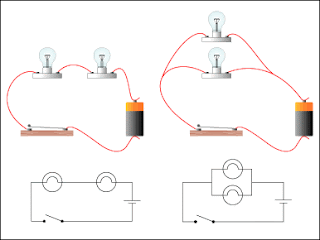Hello!
Today,
we shall talk about Series and Parallel circuits! Now, a circuit is simply a
connection of wires with various things attached to it, such as a resistor or a
light bulb. With a power source, you can create a voltage, which in turn
directs a current.
A
series circuit is just one long connection of wire with at least a power source
and a resistor, such as a lightbulb. The current in a series circuit is always
the same, and you can find this by switching around Ohm’s Law, which is V=IR.
By switching things around, you can find current: I=V/R. When you try to find
the resistance, you just add all the resistors together.
The
parallel circuit is different, because not only is it multiple wires that split
off with their own current, but they also have their own resistors. The voltage
is the same throughout the circuit, and the current is usually all the currents
from the resistors added together. To find the resistance, you simply just take
the inverse of all the resistors added together.
Can you tell which one is which?
Now,
this might seem slightly boring to you, but your whole life functions from
these silly little things. Without these, you wouldn’t have video games or a microwave,
or even electricity in your house! So be thankful that these things are here.
However, usually you find a combination of series and parallel circuits, but
that’s for another day.
Keep
learning!
~The
Scientists

No comments:
Post a Comment